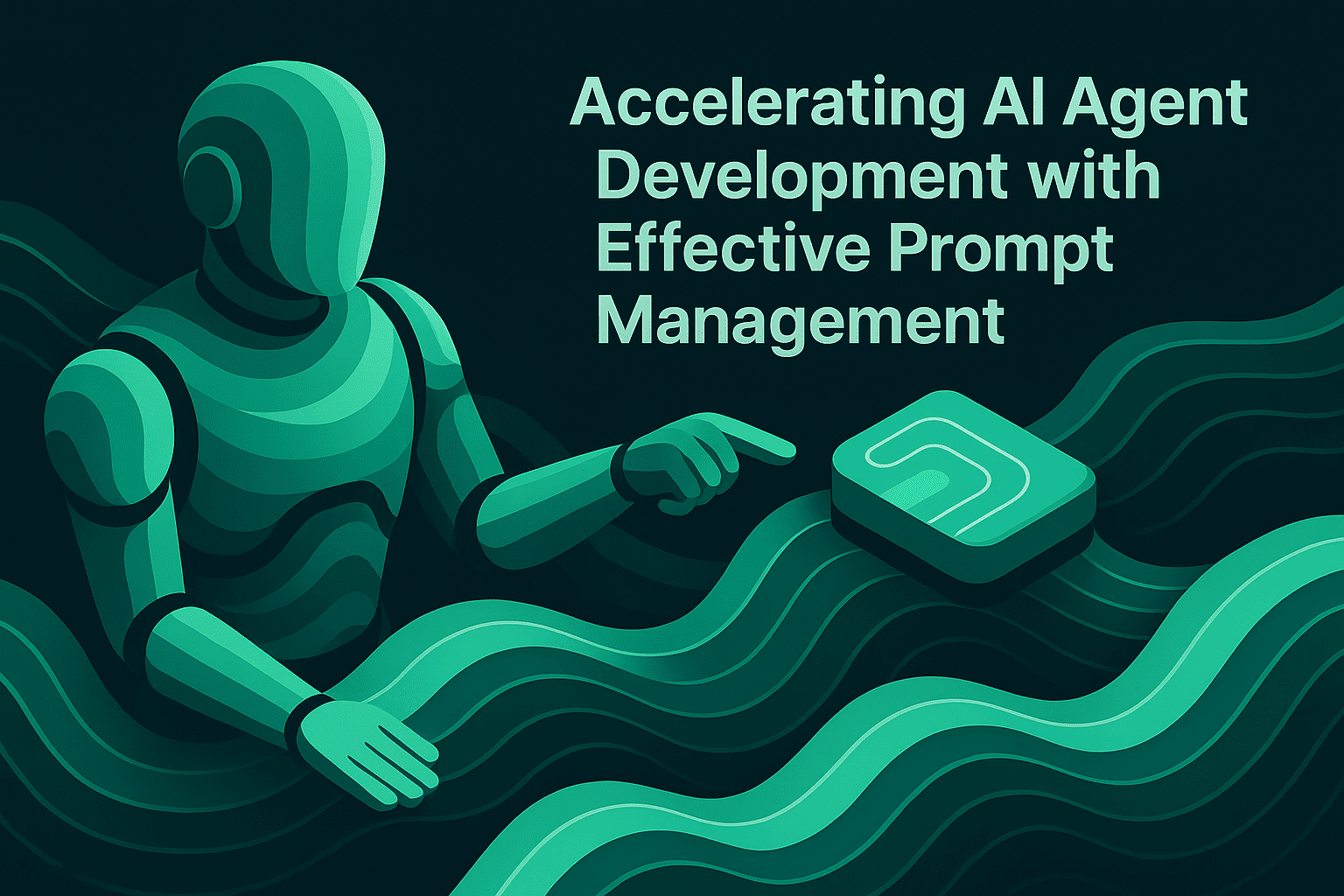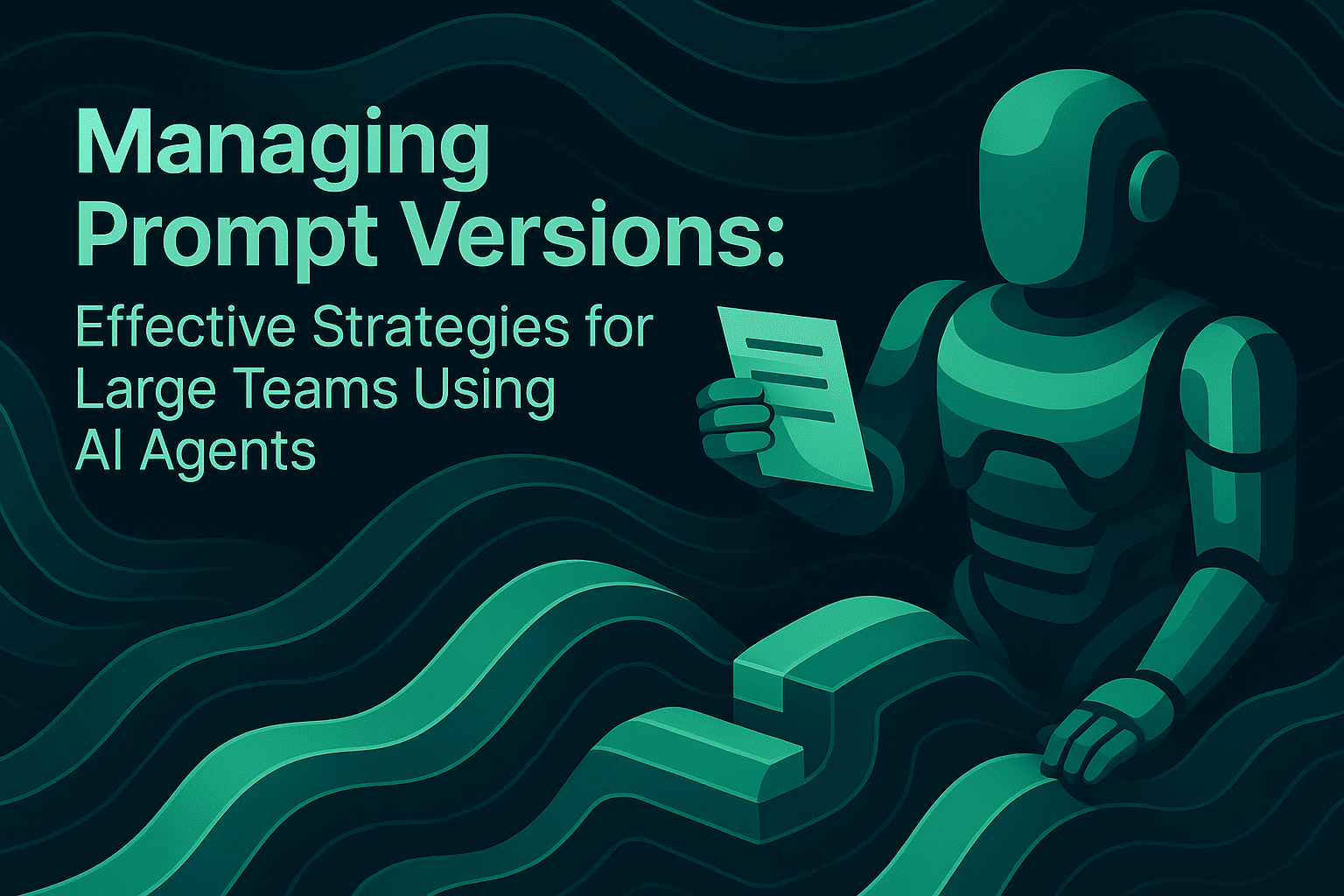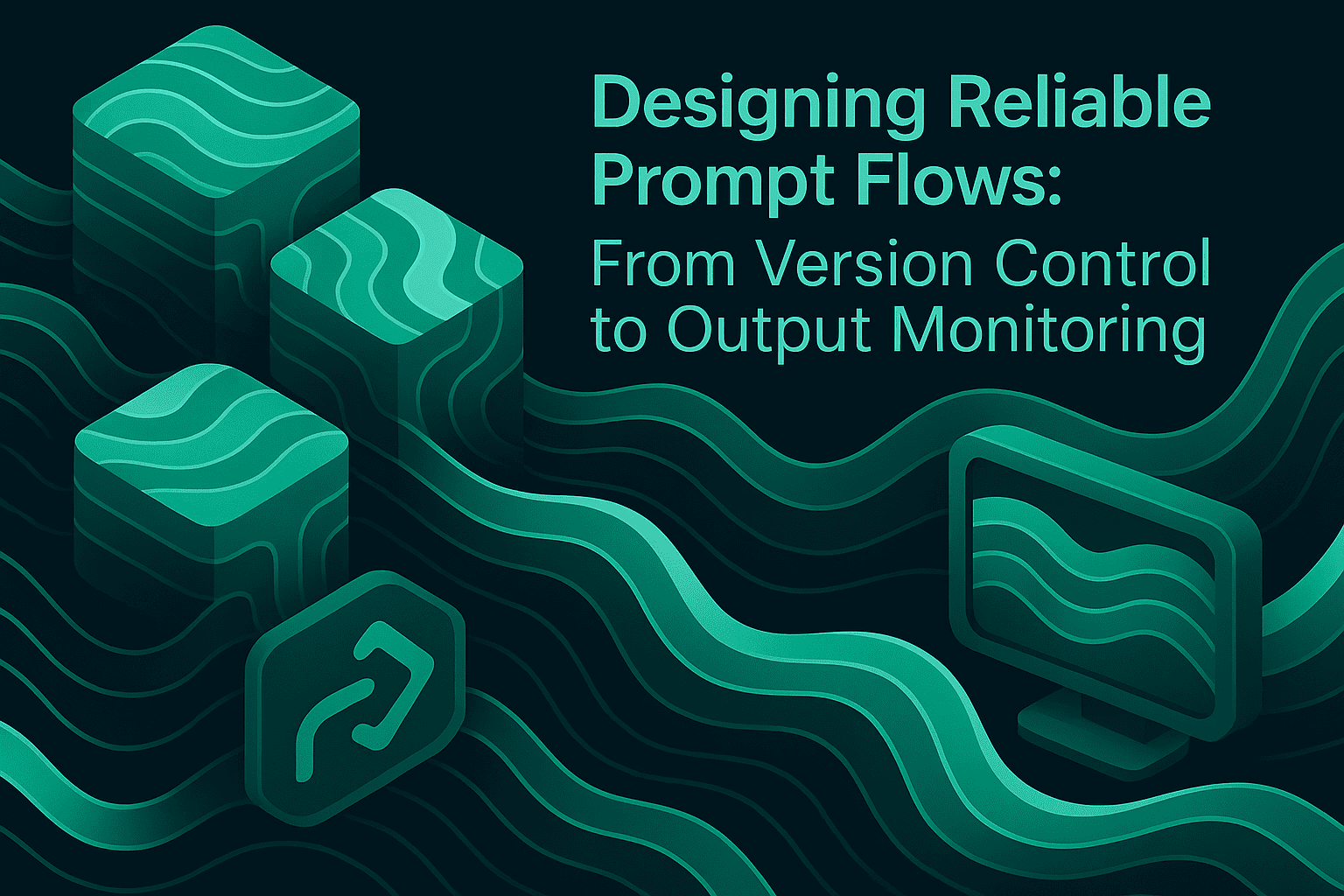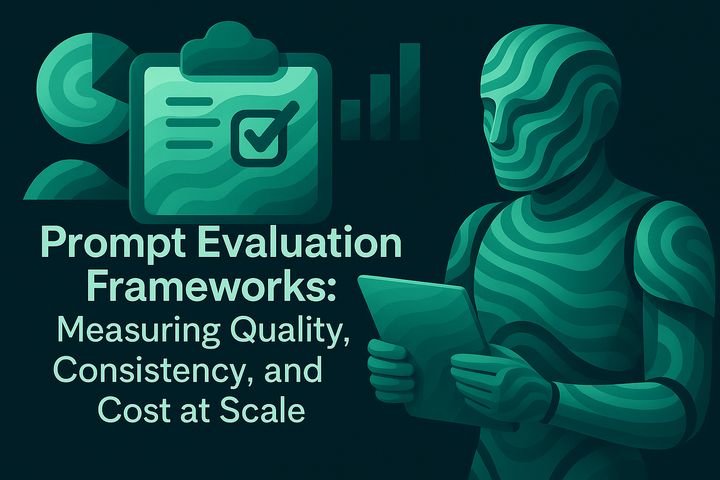Accelerating AI Agent Development with Effective Prompt Management

The landscape of AI development has evolved from simple chatbot interactions to sophisticated agent systems that autonomously navigate complex workflows and make critical decisions. As prompt engineering becomes increasingly important, building with language models is becoming less about finding the right words for prompts and more about answering the broader question of what configuration of context is most likely to generate desired model behavior. This shift demands robust prompt management strategies that go beyond ad-hoc experimentation to systematic optimization and governance.
For AI engineering teams building production-ready agents, effective prompt management has become the difference between agents that deliver consistent value and those that fail unpredictably. This comprehensive guide explores how structured prompt management accelerates AI agent development, reduces deployment risks, and enables teams to ship reliable AI systems five times faster.
The Critical Role of Prompt Management in Agent Development
Prompt management is the process of organizing, versioning, testing, and optimizing the inputs sent to AI models to elicit the best possible outputs. Unlike casual prompting, this discipline treats prompts as first-class engineering assets that require systematic collaboration, experimentation, and observability. The impact on agent behavior is profound, AI outputs are highly sensitive to prompt wording, structure, and context, where poorly managed prompts can lead to inconsistent or unreliable results.
Modern AI agents operate through multiple inference turns, accumulating context that must be carefully curated and refined. As agents generate more data that could be relevant for the next turn of inference, this information must be cyclically refined through iterative context engineering. This complexity makes prompt management not just beneficial but essential for production deployments.
The stakes are particularly high for enterprises deploying AI agents at scale. Without proper prompt management, teams face version control chaos, inconsistent agent behaviors across environments, and the inability to trace failures back to specific prompt changes. These challenges compound as organizations scale from proof-of-concept to production, where a single prompt regression can impact thousands of user interactions.
Challenges Teams Face Without Structured Prompt Management
Version Control and Collaboration Bottlenecks
Most AI teams begin with prompts embedded directly in code, creating immediate friction when non-technical stakeholders need to contribute. Product managers with deep domain expertise cannot iterate on prompts without engineering support, while engineers spend valuable time on prompt tweaks rather than infrastructure improvements. This siloed approach slows iteration cycles from hours to days.
Testing and Validation Gaps
Without systematic testing frameworks, teams deploy prompt changes blindly, discovering regressions only after production incidents. LLMs will generate an answer even if it's wrong, requiring teams to actively manage this risk. The absence of automated evaluation pipelines means every prompt modification becomes a potential liability, especially when dealing with complex multi-step agent workflows.
Observability and Debugging Limitations
When agents fail in production, teams struggle to identify whether the root cause lies in prompt design, model behavior, or system integration. The lack of prompt-specific monitoring makes it nearly impossible to correlate performance degradation with prompt modifications, leading to lengthy debugging sessions and extended downtime.
Cross-Functional Misalignment
Cross functional teams need to collaborate on designing prompts, experimenting and tracking changes over time. Without centralized prompt management, different teams maintain separate versions, leading to inconsistencies and duplicated effort. This fragmentation becomes particularly problematic when scaling AI initiatives across multiple departments or products.
Key Components of Effective Prompt Management
Prompt Versioning and Governance
Professional prompt management begins with treating prompts as versioned artifacts with clear ownership and change histories. Maxim AI's experimentation platform enables teams to organize and version prompts directly through the UI, maintaining comprehensive audit trails that track every modification, its author, and performance impact.
Version control extends beyond simple text tracking to include associated metadata: model configurations, temperature settings, and deployment variables. This granular versioning enables teams to roll back problematic changes instantly while maintaining separate prompt versions for development, staging, and production environments.
Collaborative Prompt Engineering
Building good AI is about understanding your users, which is why subject matter experts are the best prompt engineers. Effective prompt management platforms democratize prompt iteration, allowing domain experts to contribute without code changes. Visual editing interfaces enable product managers, customer support leads, and subject matter experts to refine prompts based on real user interactions.
This collaborative approach accelerates iteration cycles dramatically. Teams report completing months of prompt optimization work in single weeks when non-technical stakeholders can directly modify and test prompts. The ability to A/B test prompt variations in production further enables data-driven optimization based on actual user outcomes rather than intuition.
Automated Testing and Evaluation
Systematic prompt testing transforms agent development from guesswork to engineering. Maxim AI's evaluation framework provides comprehensive testing capabilities across machine and human evaluations, quantifying improvements or regressions before production deployment.
Teams can run automated A/B tests and evaluations on prompt variants to identify the best-performing versions. These evaluations span multiple dimensions: accuracy, latency, cost, and safety. Custom evaluators tailored to specific use cases ensure prompts meet domain-specific requirements, while regression testing prevents performance degradation as prompts evolve.
Real-Time Monitoring and Optimization
Production prompt performance requires continuous monitoring to detect degradation and identify optimization opportunities. Maxim AI's observability suite tracks prompt-level metrics in real-time, correlating agent behavior with specific prompt versions and configurations.
Advanced analytics reveal patterns invisible during development: edge cases that trigger failures, user inputs that consistently produce poor outputs, and gradual performance drift as user behavior evolves. These insights feed back into the prompt optimization cycle, creating a continuous improvement loop that maintains agent quality over time.
Best Practices for Prompt Engineering in Agent Systems
Structure and Clarity Over Complexity
The model builds a view of the world solely based on what's in the prompt, the more complete and consistent that view is, the better the model's results will be. Successful prompt engineering prioritizes clear structure over verbose instructions. Break complex behaviors into discrete, testable components rather than monolithic prompt blocks.
Implement hierarchical prompt organization: system-level instructions establish general behavior, while task-specific prompts handle individual capabilities. This modular approach simplifies debugging and enables selective updates without risking unintended side effects.
Context Window Optimization
Context engineering is the art and science of curating what goes into the limited context window from the constantly evolving universe of possible information. Effective prompt management requires strategic context allocation, prioritizing essential information while maintaining flexibility for dynamic content.
Implement progressive disclosure strategies where agents retrieve relevant context incrementally rather than front-loading all possible information. This approach maintains focus while reducing token consumption and improving response times.
Error Handling and Recovery
If the model calls a tool incorrectly, do not raise an exception in agent code but instead return a tool result that explains what the error was, the model will recover and try again. Design prompts with explicit error handling instructions that guide agents through failure scenarios gracefully.
Include fallback behaviors and clarification protocols that activate when confidence thresholds aren't met. This defensive prompt engineering prevents cascading failures and maintains user trust even when primary objectives cannot be completed.
Tool Integration and Multi-Modal Considerations
Modern agents leverage multiple tools and process diverse data types. Well-documented tools with headers, delimiters, and markdown for clarity ensure agents understand available capabilities and constraints. Structure tool definitions consistently, providing clear examples of successful invocations and expected outputs.
For multi-modal agents processing images, documents, and structured data, tailor prompts to each modality's characteristics. Visual prompts require different instructions than text analysis, and successful prompt management accounts for these distinctions systematically.
Implementing Prompt Management with Maxim AI
Rapid Experimentation and Deployment
Maxim AI's Playground++ accelerates prompt development through advanced engineering capabilities that enable rapid iteration and deployment. Teams can compare output quality, cost, and latency across various prompt-model combinations, identifying optimal configurations before production deployment.
The platform's deployment variables and experimentation strategies eliminate code changes for prompt updates, reducing deployment cycles from days to minutes. Integration with databases, RAG pipelines, and prompt tools ensures prompts operate within realistic production contexts during development.
Comprehensive Simulation and Testing
Maxim AI's agent simulation platform tests prompts across hundreds of scenarios and user personas before production deployment. Teams simulate customer interactions across real-world scenarios, analyzing agent trajectories and identifying failure points systematically.
The ability to re-run simulations from any step enables precise debugging and root cause analysis. Teams can modify prompts and immediately test improvements against problematic scenarios, ensuring fixes address underlying issues rather than symptoms.
Production-Grade Observability
Deploying prompts to production requires robust monitoring to maintain quality at scale. Maxim AI's observability features provide real-time visibility into prompt performance, enabling teams to detect and resolve issues before they impact users significantly.
Custom dashboards track prompt-specific metrics across multiple dimensions, while automated evaluations run continuous quality checks against production traffic. Alert mechanisms notify teams of performance degradation immediately, enabling rapid response to emerging issues.
Data-Driven Optimization
Maxim AI's data engine enables continuous prompt improvement through systematic data curation and analysis. Production logs feed into evaluation datasets, creating feedback loops that align prompts with actual user needs rather than anticipated requirements.
Human-in-the-loop evaluation workflows capture nuanced quality assessments that automated metrics miss. This combination of machine and human evaluation ensures prompts meet both technical specifications and user experience expectations consistently.
Measuring the Impact of Effective Prompt Management
Quantifiable Development Acceleration
Organizations implementing structured prompt management report dramatic acceleration in development cycles. Teams complete many months' worth of work in single weeks when prompt management platforms empower cross-functional collaboration. This acceleration stems from parallel iteration, automated testing, and reduced deployment friction.
Key performance indicators include reduced time-to-production for new features, decreased prompt-related incidents, and increased deployment frequency. Teams typically achieve five-fold improvements in shipping velocity while maintaining or improving quality metrics.
Enhanced Reliability and Consistency
Systematic prompt management transforms agent reliability from hopeful aspiration to measurable reality. Version control and regression testing prevent unexpected behavior changes, while production monitoring catches edge cases before they become widespread issues.
Organizations report 80% reductions in prompt-related production incidents and significantly improved mean time to recovery when issues occur. The ability to roll back problematic changes instantly minimizes user impact while teams investigate root causes thoroughly.
Improved Cross-Functional Collaboration
Democratizing prompt management enables unprecedented collaboration between technical and business teams. Product managers iterate on customer-facing behaviors independently, while engineers focus on infrastructure and integration challenges.
This collaborative approach produces agents that better align with business objectives and user needs. Customer satisfaction scores improve as domain experts directly influence agent behavior, ensuring responses reflect deep subject matter expertise rather than generic patterns.
Future-Proofing Your AI Agent Development
Scaling Prompt Management Across Organizations
As AI initiatives expand, prompt management must scale from individual projects to enterprise-wide platforms. Centralized prompt repositories enable knowledge sharing across teams, preventing duplicated effort and ensuring consistent quality standards.
Implement governance frameworks that balance standardization with flexibility, allowing teams to maintain autonomy while adhering to organizational best practices. Role-based access controls ensure appropriate oversight without creating bottlenecks that slow innovation.
Preparing for Multi-Agent Orchestration
Multi-agent orchestration represents the next frontier in AI development, requiring sophisticated prompt management across interconnected agent systems. Effective prompt management platforms must support agent-to-agent communication protocols, shared context management, and coordinated behavior optimization.
Design prompt architectures that anticipate multi-agent scenarios, implementing clear interfaces and communication standards. This forward-thinking approach ensures prompt management infrastructure supports future capabilities without requiring fundamental restructuring.
Continuous Learning and Adaptation
The rapid evolution of AI capabilities demands prompt management systems that adapt continuously. Implement learning mechanisms that identify successful prompt patterns automatically, propagating improvements across similar use cases systematically.
Establish feedback loops between production performance and prompt development, ensuring prompts evolve alongside user needs and model capabilities. This adaptive approach maintains agent relevance and effectiveness as requirements change over time.
Conclusion
Effective prompt management has evolved from optional optimization to essential infrastructure for production AI agent development. The complexity of modern agent systems, combined with the business-critical nature of their deployments, demands systematic approaches to prompt versioning, testing, and optimization.
Organizations that implement comprehensive prompt management strategies achieve dramatically faster development cycles, improved reliability, and enhanced cross-functional collaboration. By treating prompts as first-class engineering assets deserving of robust tooling and processes, teams unlock the full potential of AI agents while minimizing deployment risks.
Maxim AI's end-to-end platform provides the complete prompt management infrastructure necessary for enterprise-grade agent development. From initial experimentation through production deployment and continuous optimization, teams gain the visibility and control necessary to ship AI agents reliably and rapidly.
Ready to accelerate your AI agent development with professional prompt management? Schedule a demo to see how Maxim AI can transform your prompt engineering workflows and help you ship production-ready agents five times faster.


